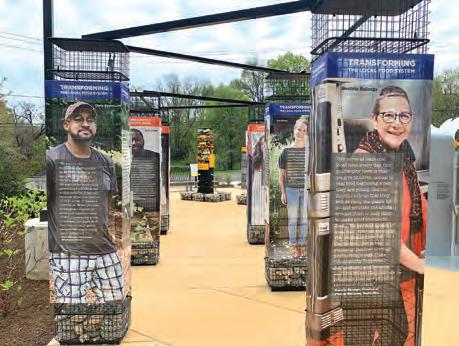
4 minute read
Food for the People – Latest Exhibit at the Anacostia Community Museum
Food for the People
Latest Exhibit at the Anacostia Community Museum
On the Anacostia Community Museum’s outdoor plaza, tall pylons and colorful sculptural elements invite the public to rethink the way they look at food and how they consume it. The curated installation is part of the museum’s latest exhibition, “Food for the People: Eating and Activism in Greater Washington,” on view through Sept. 17, 2022. The museum has planned an extensive interactive public programming schedule to coincide with the exhibition. While the museum plans on reopening sometime this summer, “Food for the People,” like the museum’s “31 Men of Change” exhibition unveiled in Deanwood earlier this year, provides an accessible outdoor educational experience as the pandemic begins to recede.
“Food for the People” challenges us to rethink not only what we eat and how we obtain our food but who produces and distributes it. A detailed discussion of food accessibility addresses the disparities in the DC region with regard to “food insecurity,” which the exhibition defines as “limited or uncertain access to affordable, nutritionally adequate food.”
“Food for the People’ sheds light on issues of food insecurity in our region and recognizes the individuals and organizations working to increase access and affordability,” said Melanie Adams, director of the museum. “The exhibition offers a safe, outdoor experience where visitors can be introduced to food-justice issues in the Washington, DC, area, as well as local people and ideas that are making our food system more just and sustainable.”
The statistics regarding food waste in the United States are astounding, according to the exhibition’s curatorial script, a downloadable guide available online (see below for link to the PDF). We live in a land of abundance. The US cultivates 40 million more acres than needed to feed everyone in this country comfortably, meaning that we have a significant surplus. In fact, we produce so much food that those who can afford to buy it waste it regularly and in large quantities. The National Resources Defense Council estimates that 40% of the food supply is wasted each year. What exactly does this mean? Wasted food fills up our municipal dumps rather than the stomachs of those who struggle to find their next meal.
Despite our nation’s cornucopia, approximately 11% of all households regularly experience food insecurity. By contrasting and analyzing the statistics compiled about food production and waste, “Food for the People” dispels any doubt that scarcity causes food insecurity here.
Curator and lead researcher Samir Meghelli has spent the past two years studying the data and interviewing food justice activists and leaders. “One striking statistic regarding food access in our area is that DC’s wealthiest and whit-
by Phil Hutinet
The outdoor “Food for the People: Eating and Activism in Greater Washington” exhibition at the Smithsonian’s Anacostia Community Museum. Photo: Samir Meghelli, Curator est ward has a full-service grocery store for every 9,336 residents, whereas our least wealthy and most African American ward has one store for every 85,160 residents,” he said. “A critical component of ‘Food for the People’ is that it offers suggestions for how visitors can contribute to making a more just and sustainable food system in their local communities.”
The exhibition and programming offer solutions to overcome food insecurity by highlighting the work done by leaders and activists from



the greater Washington area. The exhibition also investigates avenues for change and reform with regards to food accessibility that can be applied nationwide.
For example, Mary Blackford, a Ward 7 resident, decided to bring quality food to her neighborhood after nishing business school. Inspired by a trip she took to Ghana, where she witnessed rsthand the power of cooperative economics, Blackford helped found Market Seven, which will be a “community food hall” slated to open in the Benning Neighborhood sometime this year. Blackford explains that “it’s hard to eat healthy when you live in a food desert or when the quality of the grocery stores you have is not that great. In Ward 7, there’s not much fresh anything. They may have a couple of bananas at the 7-Eleven. Eventually I said, ‘We just need our own market here. That’s the real solution.’ And we did it.”
In addition to showcasing the work of reformers, the exhibition honors farmworkers, meat processors, grocery store clerks and restaurant workers. Sculptural tributes acknowledge and value food workers’ contribution to society, a contribution which literally makes life possible for the rest of us.
The Anacostia Community Museum is located at 1901 Fort Place SE, Washington, DC 20020. Visit the museum’s website at www. anacostia.si.edu. Follow the outdoor exhibition by downloading the curatorial script: https://anacostia.si.edu/Content/img/Newsroom/FFTP_Outdoor_Exhibition_Script.pdf.
For information about Market 7 visit https://www.market7dc.com/ about-us.
Phil Hutinet is the publisher of East City Art, DC’s alternative art source. For more information visit www.eastcityart. com. ◆

Serving Capitol Hill since 1984 Custom designed mats • Wide selection • Work done on premises
513 11TH ST. SE (EASTERN MARKET METRO) 202.544.7577 www.newmangallery.com
ROTATING EXHIBITS OF LOCAL ARTISTS







